Homepage > News items (2025) - (2024) - (2023) - (2022) - (2021) - (2020) - (2019) - (2018) - (2017)
Monthly news items, video links and blog on the Frans Absil Music website
News Archive 2019
December 2019: Tutorial about composing with 12-tone triads and Arranging Technique video series completed
New composition and arranging technique videos on the YouTube channel.
- In the Music Composition Techniques playlist I started a tutorial series
about composing with 12-tone triads, that is, sets of four triads that together cover all chromatic pitch-classes.
 The first episode is called
Twelvetone Triads and Hexachords: Part 1 Polychord Structures and Properties (24:12) and discusses the pairwise combination of triads into hexachords. These have a corresponding Pitch-Class Set prime form label and a Hindemith Chord Group classification. Triad pairs are stacked as polychords with a Ulehla Chord Tension Level, depending on the dissonance distribution over the chord structure. The video contains polychord voicing, chord progression and two composition examples.
The first episode is called
Twelvetone Triads and Hexachords: Part 1 Polychord Structures and Properties (24:12) and discusses the pairwise combination of triads into hexachords. These have a corresponding Pitch-Class Set prime form label and a Hindemith Chord Group classification. Triad pairs are stacked as polychords with a Ulehla Chord Tension Level, depending on the dissonance distribution over the chord structure. The video contains polychord voicing, chord progression and two composition examples.
- The Arranging Techniques video tutorial series for 2019 has been completed with Episodes 19 and 20 about writing Percussive Ensemble phrases for a jazz big band.
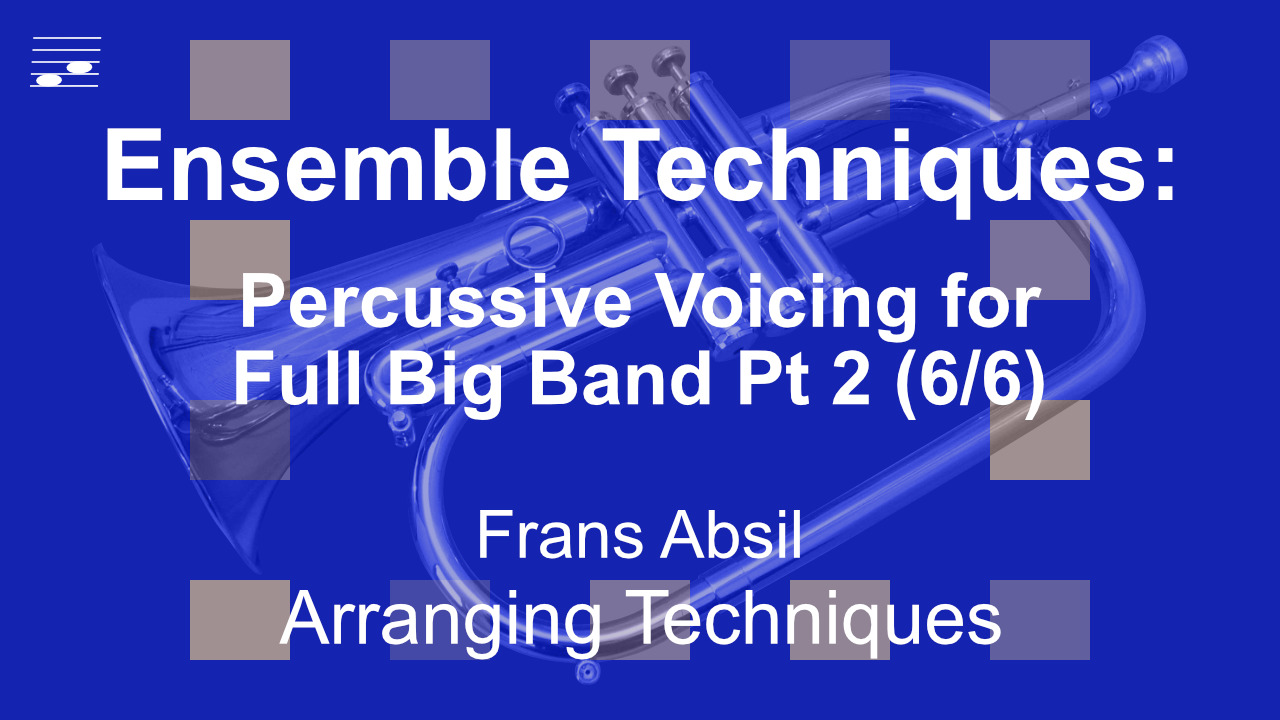 The final episodes focus on chordal function assignment in percussive big band tutti phrases over the saxophone, trumpet and trombone section. Watch:
Ensemble Techniques [6/6]: Percussive Voicing for Full Big Band Part 2 (15:51).
Ensemble Techniques [5/6]: Percussive Voicing for Full Big Band Part 1 (12:09).
You'll find these episodes in the Arranging Techniques playlist. This tutorial series is companion material to the book
"Arranging by Examples: The Practical Guide to Jazz and Pop Orchestra Arranging, 3rd Edition."
The final episodes focus on chordal function assignment in percussive big band tutti phrases over the saxophone, trumpet and trombone section. Watch:
Ensemble Techniques [6/6]: Percussive Voicing for Full Big Band Part 2 (15:51).
Ensemble Techniques [5/6]: Percussive Voicing for Full Big Band Part 1 (12:09).
You'll find these episodes in the Arranging Techniques playlist. This tutorial series is companion material to the book
"Arranging by Examples: The Practical Guide to Jazz and Pop Orchestra Arranging, 3rd Edition."
November 2019: Arranging video tutorial and a new composition
New content on the YouTube channel, a fresh composition for big band and more music software 'surprises'.
- In the Ensemble Techniques tutorial series
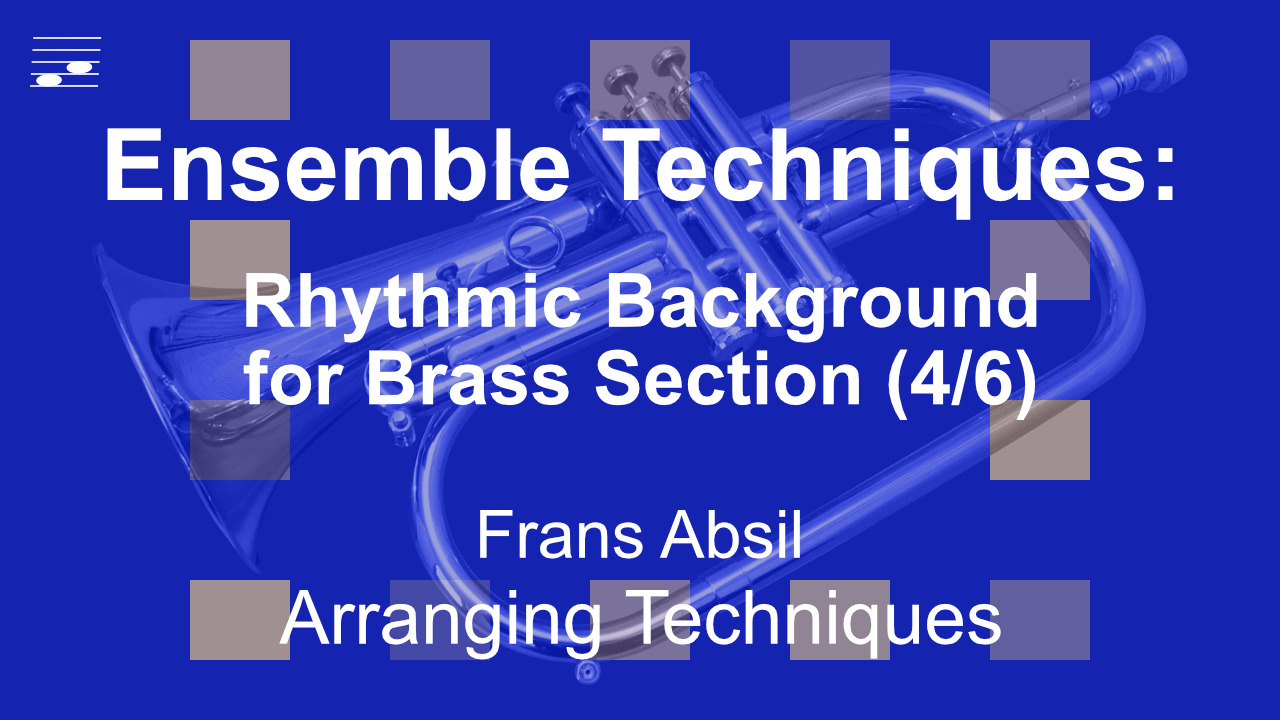 we focus once more on percussive tutti settings with
Episode [4/6] Rhythmic Background for Brass Section (13;24).
You'll find the episode with a set of brass section example voicings in various registers in the Arranging Techniques playlist. This series is companion material to the book
"Arranging by Examples: The Practical Guide to Jazz and Pop Orchestra Arranging, 3rd Edition."
we focus once more on percussive tutti settings with
Episode [4/6] Rhythmic Background for Brass Section (13;24).
You'll find the episode with a set of brass section example voicings in various registers in the Arranging Techniques playlist. This series is companion material to the book
"Arranging by Examples: The Practical Guide to Jazz and Pop Orchestra Arranging, 3rd Edition." - The composition
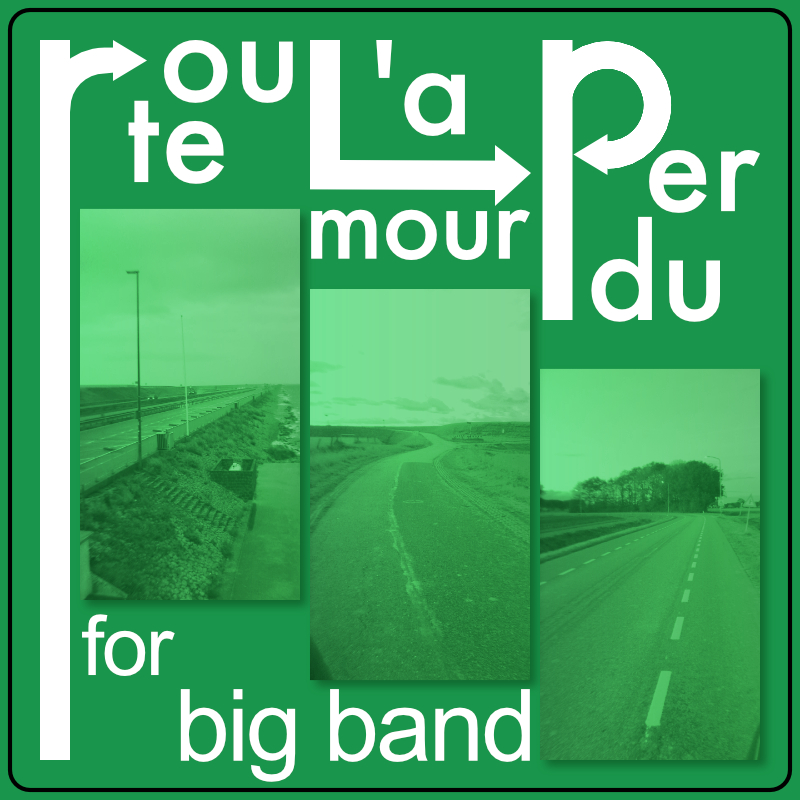 'Route l'amour perdu' is a moderate tempo piece for big band in contemporary jazz style. It has the saxophone section doubling on woodwinds, various brass mutes, contemporary harmonies (bitonal, polychord, cluster voicings) and features the keyboard player (piano, synth), lead trombone and 2nd trumpet. There's a full score in PDF format, an audio demo on SoundCloud and a YouTube movie with production details and road travel imagery.
Read more >>
'Route l'amour perdu' is a moderate tempo piece for big band in contemporary jazz style. It has the saxophone section doubling on woodwinds, various brass mutes, contemporary harmonies (bitonal, polychord, cluster voicings) and features the keyboard player (piano, synth), lead trombone and 2nd trumpet. There's a full score in PDF format, an audio demo on SoundCloud and a YouTube movie with production details and road travel imagery.
Read more >>
- Creating the audio demo for my new big band composition generated additional music software surprises (see the previous months).
- I prepared a big band template in Logic Pro X 10.4.4 (LPX) with all instruments loaded in a Vienna Ensemble Pro 6 (VEP6) project (5 instances). I defined Articulation Sets for the SWAM Woodwinds and Saxes, and Sample Modeling Brass. Unfortunately, including brass mutes (CC100) in such sets prevents the use of CC100 in LPX Automation Lanes. So I removed those and used Note-on Keyswitches only. The next surprise was the default selection of the first articulation until there is a note with articulation specified. This makes these sets impractical for control of SM Brass special playing techniques. Bug for Brass!
- After weeks of template development, testing, and Midi programming, another stroke of bad luck happened when finally bouncing the composition to stereo out in LPX Offline bouncing mode. This triggered random hanging brass notes, most often in tutti sections. Never happened with the familiar LPX Track Stack approach, but now my racehorse MacBook Pro 2018 could not cope for mysterious reasons. The Midi data flow in this setup is rather complex: LPX Midi -> VEP6 server plugin -> VEP instance -> Midi Port -> Midi Channel -> Instrument. There are continuous flows of CC1, 11, 19, 26, 27 and Pitchbend data for more realism. Could be Midi data overload; I gave up after 2 hours of detective work. The workaround is Realtime Bouncing. Since reading threads on Logic Pro Help (logicprohelp.com) and VI-Control (vi-control.net) it is clear that I am not the only person having gone down this rabbit hole. Thank you, Apple, for yet another amazing experience.
<< Previous - Top of page - Next >>
October 2019: Arranging video tutorials 'Ensemble Techniques'
New content on the YouTube channel and an update on my music software struggles.
- I started working on the
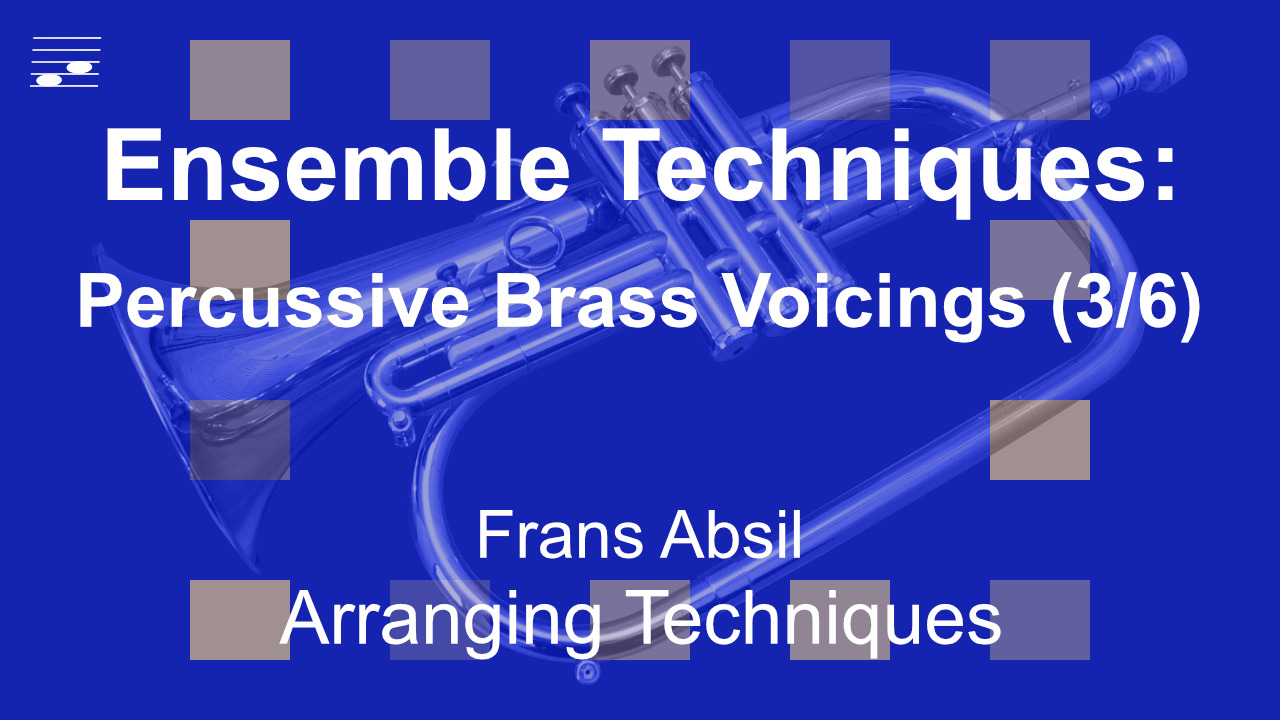 Ensemble Techniques tutorial series in the Arranging Techniques playlist. Three episodes have been finished:
Episode [1/6] Distribution of 4-Part Sectional Harmony (14:26),
Episode [2/6] Brass Section Voicing for Extended Chords (16:15), and
Episode [3/6] Percussive Brass Voicings (9:04).
Watch examples with part distribution of sectional harmony settings and extended chords over the saxophone, trumpet and trombone section.
Ensemble Techniques tutorial series in the Arranging Techniques playlist. Three episodes have been finished:
Episode [1/6] Distribution of 4-Part Sectional Harmony (14:26),
Episode [2/6] Brass Section Voicing for Extended Chords (16:15), and
Episode [3/6] Percussive Brass Voicings (9:04).
Watch examples with part distribution of sectional harmony settings and extended chords over the saxophone, trumpet and trombone section. - In the September 2019 news I wrote about the incorrect rendering of chromatic pitches when exporting from Logic Pro X (LPX) 10.4.4 as MusicXML and then importing into Finale 25 (Fin). Well, I found another workaround, doing a basic test with a quarter note chromatic scale. The key signature in LPX is C Major. The Finale import shows correct durations, but pitches are displayed as diatonic: c-c-d-e-e-f-f-g-a-a-b-b. The solution was to open the Key Signature tool window, set the key to C Major and tick the box for Hold Notes to Original Pitches [Enharmonically]! Then the flat/sharp alteration symbols will appear. So apparently the key signature export in LPX (my suspect) somehow confuses Finale. I will not delve into the MusicXML standard, and investigate further. Instead, I find it ridiculous to even have to do such a basic test with 2019 professional music software.
-
I investigated sound design for the unique Buchla Easel V synthesizer from the Arturia V Collection of virtual instruments.
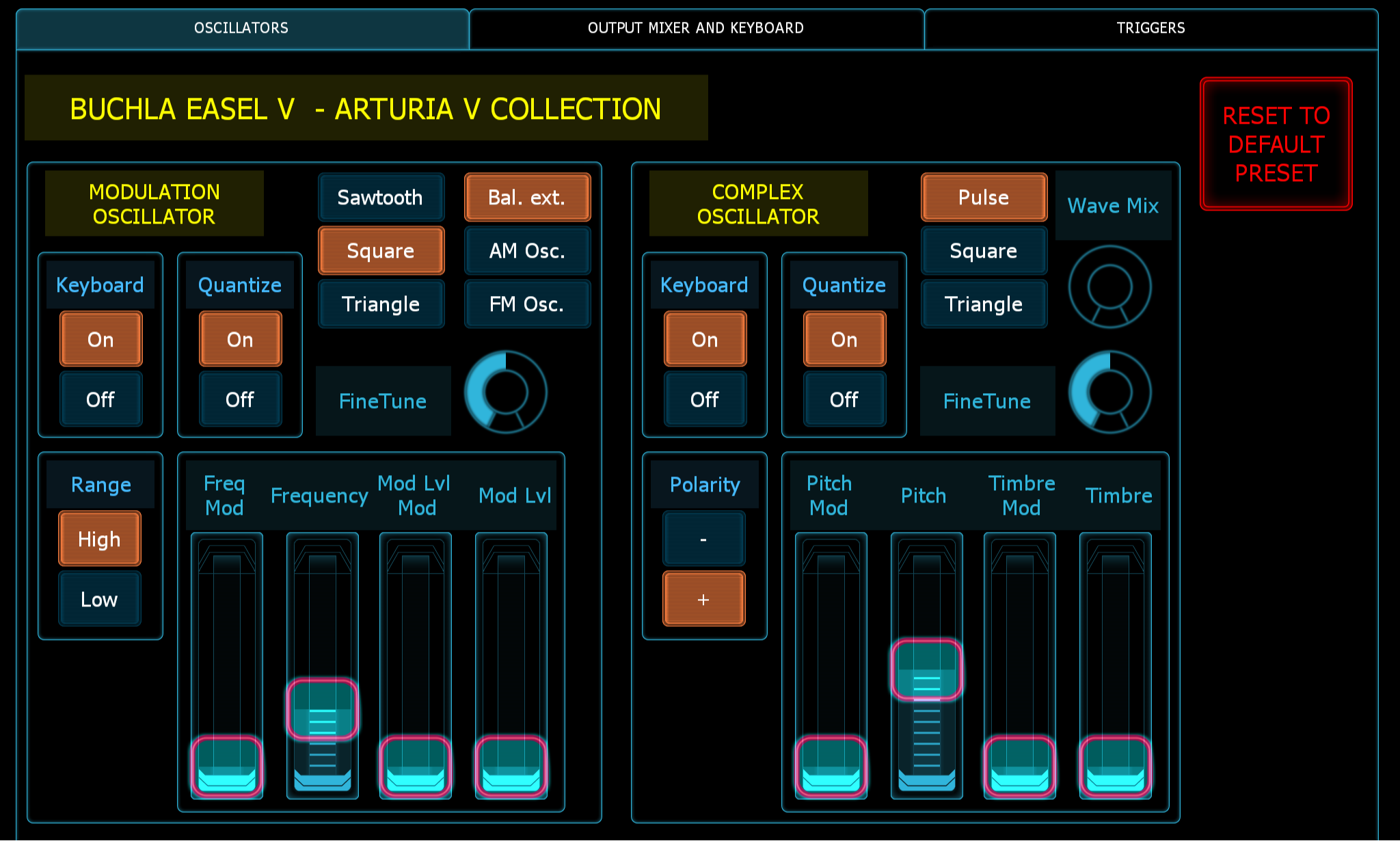 In order to minimize computer mouse RSI risk, I designed an iPad Lemur Midi Controller with the default Buchla Midi CC number configuration. Testing this controller revealed peculiar behaviour of the 7 rotary knobs on the Buchla GUI. Some of them respond linearly to Midi CC input (as expected), but others have a sigmoid response curve (no change at extreme controller values, strong changes in the range 55-75). This occurs for both the standalone and the AU/VST plugin versions. After another period of extensive error checking and testing of this established product with numerous users, I reported the problem to Arturia. They will correct this response behaviour. There's never a dull moment in music software usage.
In order to minimize computer mouse RSI risk, I designed an iPad Lemur Midi Controller with the default Buchla Midi CC number configuration. Testing this controller revealed peculiar behaviour of the 7 rotary knobs on the Buchla GUI. Some of them respond linearly to Midi CC input (as expected), but others have a sigmoid response curve (no change at extreme controller values, strong changes in the range 55-75). This occurs for both the standalone and the AU/VST plugin versions. After another period of extensive error checking and testing of this established product with numerous users, I reported the problem to Arturia. They will correct this response behaviour. There's never a dull moment in music software usage.
<< Previous - Top of page - Next >>
September 2019: Video tutorial 'Harmony Dissonance Control with Ulehla Chord Tension Level'
New content on my YouTube channel and fresh music software woes.
-
In her book on contemporary harmony Ludmila Ulehla discusses dissonance control and proposes a chord tension level scheme.
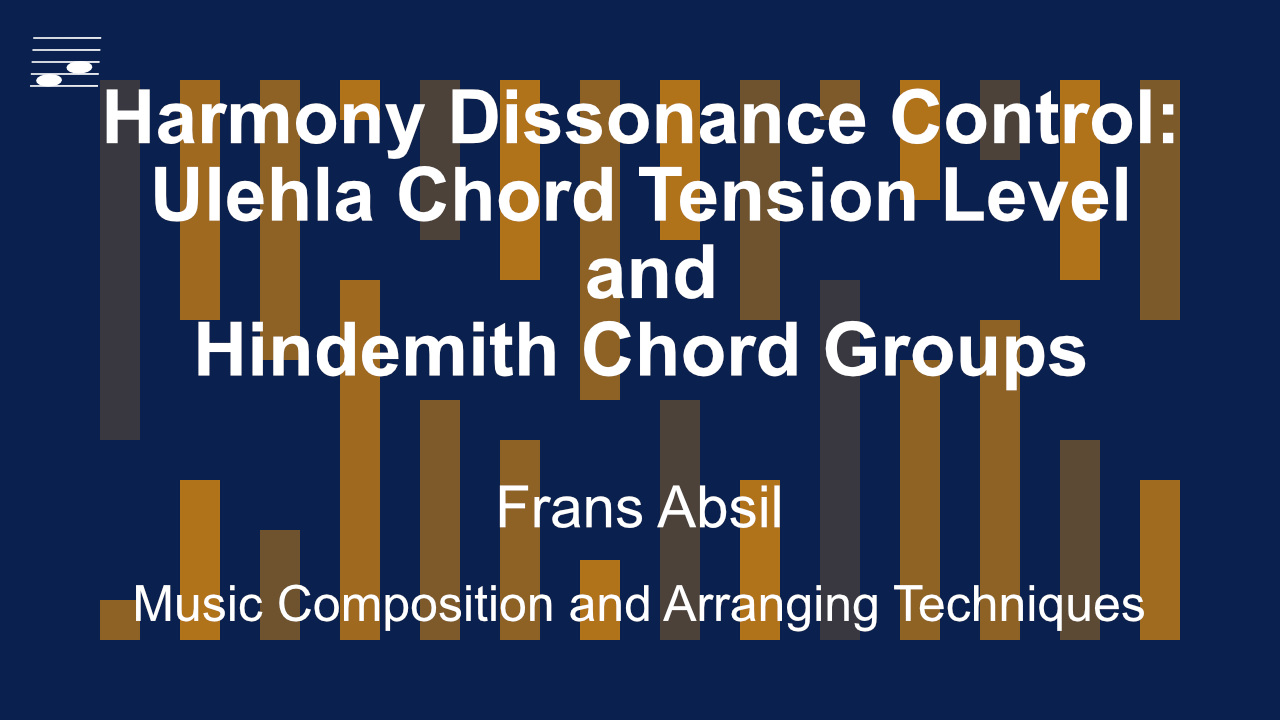 In the Music Composition Techniques playlist I've prepared a video tutorial
with chord structure examples for all nine tension levels and a mapping on the six Hindemith chord groups. Watch
Harmony Dissonance Control: Ulehla Chord Tension Level and Hindemith Chord Groups
(29:40).
Tension control is demonstrated in Schillinger chord progressions, discussing root movement, tension curve, voice leading and dissonant chordal function handling. Two of these progressions are used in musical composition examples.
In the Music Composition Techniques playlist I've prepared a video tutorial
with chord structure examples for all nine tension levels and a mapping on the six Hindemith chord groups. Watch
Harmony Dissonance Control: Ulehla Chord Tension Level and Hindemith Chord Groups
(29:40).
Tension control is demonstrated in Schillinger chord progressions, discussing root movement, tension curve, voice leading and dissonant chordal function handling. Two of these progressions are used in musical composition examples. - Over the past month I experienced more music software woes. In the search for a better workflow I turned to the 2018 MacBook Pro with Logic Pro X (LPX) 10.4.4 installed, the most stable version before the disastrous 10.4.5 release and the 10.4.6 quick-fix follow-up. Music notation is done with Finale 25 (Fin25), the same version as on the MacPro 2009 workhorse. Preparing the YouTube video tutorial about the Ulehla chord tension classification scheme I exported MusicXML scores from LPX. Importing this format into Fin25 is reliable on the MacPro with LPX 10.3.2, but now there was another big surprise. Importing MusicXML from LPX 10.4.4 made all accidentals disappear! So I had to spend hours on switching between LPX and Fin25 to meticulously inspect each part and correct accidentals. Fortunately the composition examples were less than 30 measures long. Imagine this disaster for an extended composition. After an online search I found a limited solution in a 2018 forum post. The culprit software could not be pinpointed but the workaround is to use the Fin25 Midi/Audio > Retranscribe command. This restores the accidentals, but obviously may ruin the note durations, depending on the Quantization Settings. Well, I stick with the estimate that I spend about half of my time on repairing operating system and software installation problems and identifying application bug workarounds, instead of being creative.
- After reporting a non-working controller object naming issue to Arturia a while ago (see May 2019), with the release of the Midi Control Center V 1.9.1 software one may finally start to use the Arturia KeyLab 61 Mk2 as a generic Midi CC controller. Oh, and I had the audacity to report my first Logic Pro bug to Apple. Feels like telling God that His Creation is not perfect. Probably I will be banned to music software hell forever.
<< Previous - Top of page - Next >>
August 2019: Video tutorial series on 5-part Sectional Harmony
New video tutorials for my YouTube channel and workflow optimisation update.
- The
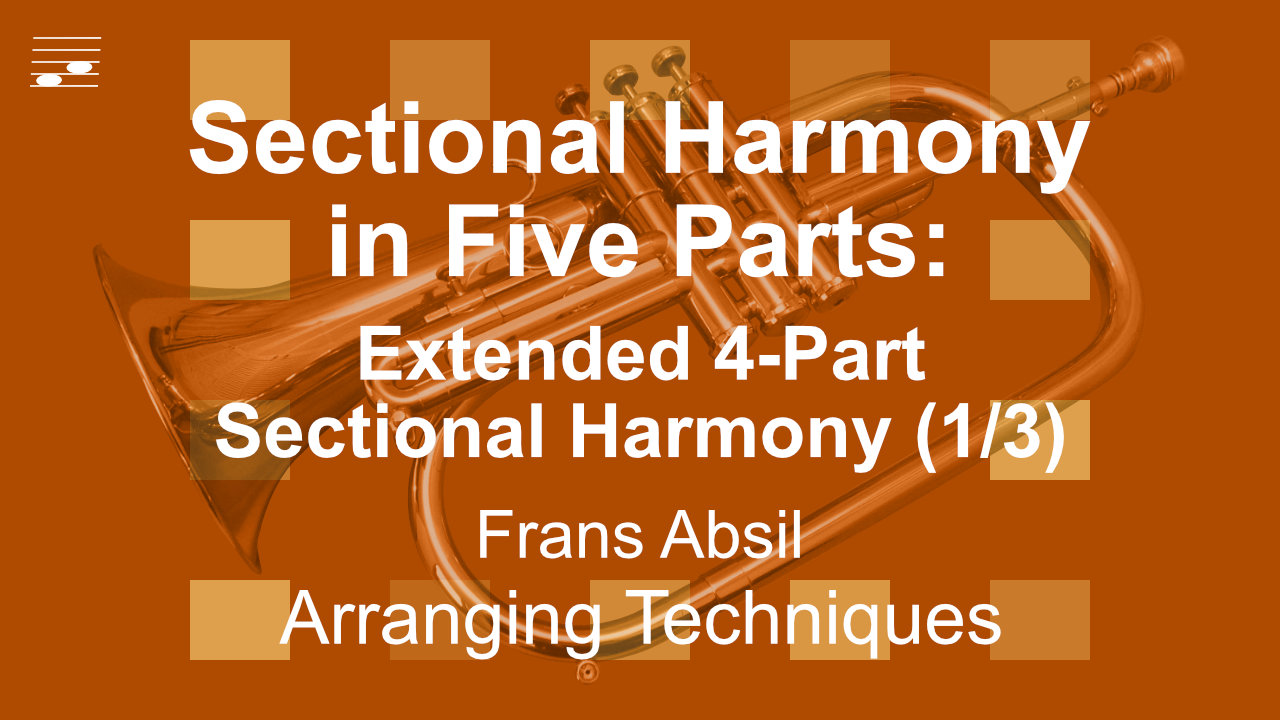 Sectional Harmony in Five Parts tutorial series in the Arranging Techniques playlist consists of three episodes:
Episode [1/3] Extended 4-Part Sectional Harmony (7:16),
Episode [2/3] Chords in Fourths (8:23), and
Episode [3/3] Combining Techniques (6:34).
In general this arranging technique yields a more modern idiom in jazz, studio and pop orchestra writing. In each episode find annotated score and audio examples, discussing voicing aspects and playing the full section plus the individual parts. This is companion material to the book
"Arranging by Examples: The Practical Guide to Jazz and Pop Orchestra Arranging, 3rd Edition."
Sectional Harmony in Five Parts tutorial series in the Arranging Techniques playlist consists of three episodes:
Episode [1/3] Extended 4-Part Sectional Harmony (7:16),
Episode [2/3] Chords in Fourths (8:23), and
Episode [3/3] Combining Techniques (6:34).
In general this arranging technique yields a more modern idiom in jazz, studio and pop orchestra writing. In each episode find annotated score and audio examples, discussing voicing aspects and playing the full section plus the individual parts. This is companion material to the book
"Arranging by Examples: The Practical Guide to Jazz and Pop Orchestra Arranging, 3rd Edition." - Last month I wrote about my disappointing software experience when creating video tutorials and the efforts at workflow optimisation. There was most useful and friendly reader feedback, sharing similar frustration and with suggestions for improvement. This encouraged me to do a fresh test, linking the Finale music notation software as a ReWire slave to the Logic Pro X (LPX) DAW master. I had tried several approaches in October 2017, which were supposed to work, but always turned out erratic when applied to a realistic example composition. After verifying up-to-date software installation, I ran an orchestral test scenario. This time both programs stayed in sync (playhead position), while editing the tempo track in Logic. I tested tempo steps, linear gradients and curves (acc., rit.). Then I confirmed that ScreenFlow captured the Finale movie and Logic audio simultaneously. So there may be light at the end of the tunnel, and I no longer have to present fixed tempo examples only.
- Another optimisation step is the combination of Finale, Logic or Cubase 10 (CB10) as Midi source with sample library and virtual instrument audio playback from multiple Vienna Ensemble Pro (VEP) instances. In order to create a fresh Logic orchestral template, that sends to Midi Multiports on the VEP server I used the
LPX and VEP connection approach presented by media composer Alex Cap on his YouTube channel. A great time saver that works flawlessly. (I am aware of the Multiport option as part of the AU3 standard; that will affect future setups.) This also required lots of learning, testing, creating multi-instruments in Native Instruments Kontakt, developing instances in VEP with balanced multichannel stereo output and some local audio FX processing. Currently I am tuning the template. Another most laborious job was writing down all instrument Midi key ranges, key switches and controller numbers. I need those to implement Articulation ID sets in LPX and Expression Maps in CB10 in the near future.

<< Previous - Top of page - Next >>
July 2019: More Youtube tutorials and workflow optimisation search
Producing video tutorials for my YouTube channel has its ups and downs:
- The
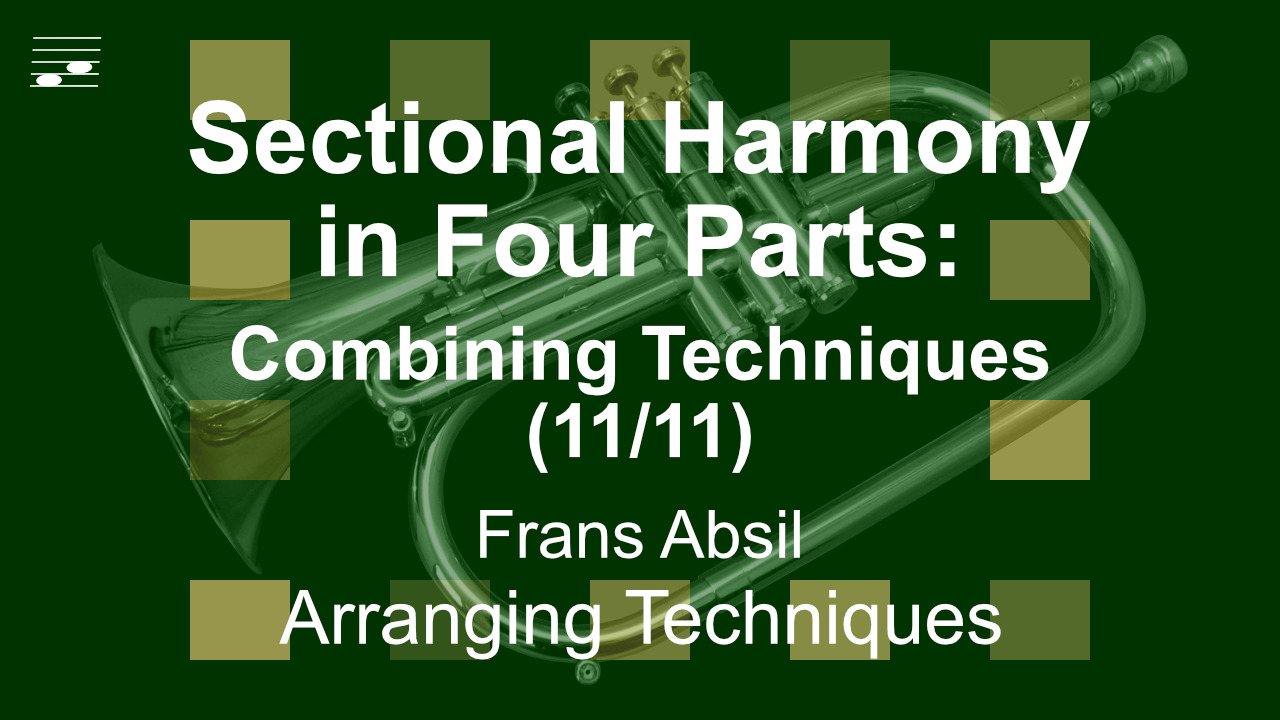 Sectional Harmony in Four Parts tutorial series in the Arranging Techniques playlist is completed with Episode [11]:
Combining Techniques (7:34). Various techniques are illustrated in a swing jazz/blues example, serving as companion material for the book
"Arranging by Examples: The Practical Guide to Jazz and Pop Orchestra Arranging, 3rd Edition." Next there will be a series on 5-part sectional harmony.
Sectional Harmony in Four Parts tutorial series in the Arranging Techniques playlist is completed with Episode [11]:
Combining Techniques (7:34). Various techniques are illustrated in a swing jazz/blues example, serving as companion material for the book
"Arranging by Examples: The Practical Guide to Jazz and Pop Orchestra Arranging, 3rd Edition." Next there will be a series on 5-part sectional harmony. - Also the 2-episode series on Hybrid Four-Part Harmony is completed. Watch Schillinger Hybrid Four-Part Harmony: Chord Progressions and Examples, Part 2 (23:36). There are more examples of writing progressions with higher tension, extended chords in the diatonic and symmetric harmony systems. Voice leading aspects are demonstrated with alternative transformations and the use of parallelism when connecting chords. You will find this movie in the Music Composition Techniques playlist.
- Publishing these YT video tutorials involves considerable reviewing. In fact, the many revisions take too much of my time. Some of these errors are mine, but poor software quality and reliability is maddening. Believe me, I have sufficient software user and programming mileage, I do read manuals and consult online information. Here are a few of my worst experiences:
- Although I am an experienced user of and admire the flexibility in the Finale music notation software, the audio rendering is horrible and too complicated. Set-up for good quality sample playback is a disaster. In user forums, one reads regular complaints about output volume differences for various libraries (where is the clarinet, can't hear the snare drum, Kontakt player not selected, etc.).
- Anything about the Schillinger System of Musical Composition meets controversy. I am not a blind follower, but when identifying a useful technique I like to illustrate its potential and hopefully inspire viewers with a realistic and well-produced composition example. For that I use Logic, combined with Finale movies of condensed, annotated scores. However, transferring Midi or MusicXML between these programs is another source of frustration. Notwithstanding the key and tempo indications, the note alterations, even simple things such as Midi pitches get messed up, and I tediously have to check every part and region for errors. I tested Tempo Map copying, but each time using the procedure in a composition example with realistic tempo alterations, it ends up a horrible experience. Human Playback in Finale is a source of misery, tempo editing too cumbersome. So then the playhead cursor in my Finale movies is out of sync with the Logic audio export. That's the reason why my short compositions always have fixed tempo.
- The video tutorials are created with ScreenFlow, a piece of software I first embraced with great enthousiasm. But, being quite a perfectionist, I prefer to edit the geometry of figure, movie and animation objects in the appropriate number value fields. That's another killer, since e.g. pressing Escape inevitably leads to error reporting. I need system audio capturing with my Finale chord progression movies (rendered with Spitfire Audio Symphonic String Ensemble samples). Well in almost 50% of cases there is an audio error (clicks, noise bursts) and I have to redo them. Requires careful listening and keep fingers crossed. One software update completely killed system audio capturing (on the old Mac Pro workhorse) and I had to re-install an earlier version. Timeline operations (moving, cutting, etc.) and the addition of annotations (arrows, lines, rectangle in the right colour and line thickness) need maximum concentration. Always manages to raise my aggression level considerably.
<< Previous - Top of page - Next >>
June 2019: Composition and Arranging Technique movies
There's a set of new video tutorials on the YouTube Channel :
- Watch
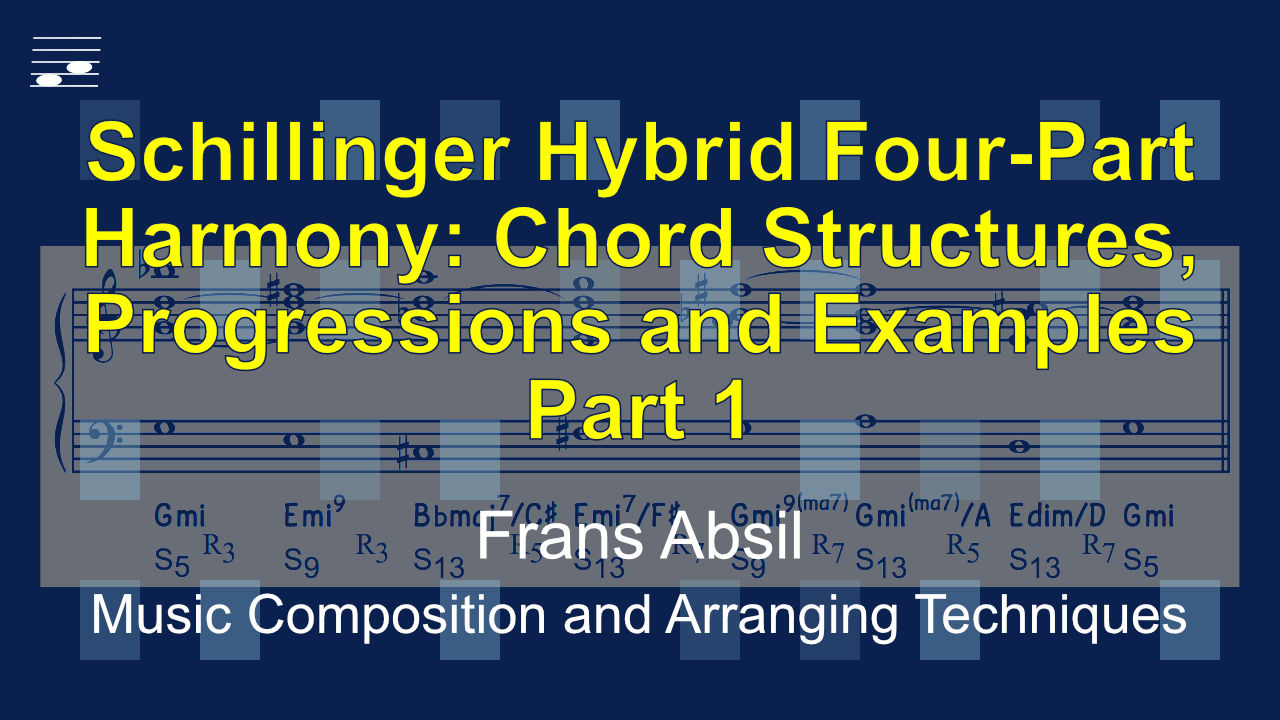 Schillinger Hybrid Four-Part Harmony: Chord Structures, Progressions and Examples, Part 1 (24:03).
In the diatonic and symmetric harmony system series of higher tension and extended chords can be used when writing hybrid four-part harmony chord progressions. With this technique from the Schillinger System of Musical Composition, one may connect triads, sevenths, ninths, elevenths and thirteenth chords. Use the two-layer approach with root in the bass and 3-part upper chordal functions. Strict voice leading requirements are removed. This tutorial presents the fundamentals, the possible chord structures, progressions and examples. You will find this movie in the Music Composition Techniques playlist.
Schillinger Hybrid Four-Part Harmony: Chord Structures, Progressions and Examples, Part 1 (24:03).
In the diatonic and symmetric harmony system series of higher tension and extended chords can be used when writing hybrid four-part harmony chord progressions. With this technique from the Schillinger System of Musical Composition, one may connect triads, sevenths, ninths, elevenths and thirteenth chords. Use the two-layer approach with root in the bass and 3-part upper chordal functions. Strict voice leading requirements are removed. This tutorial presents the fundamentals, the possible chord structures, progressions and examples. You will find this movie in the Music Composition Techniques playlist.
- In the Arranging Techniques playlist, presenting audio companion material for the book "Arranging by Examples: The Practical Guide to Jazz and Pop Orchestra Arranging, 3rd Edition," there are two new episodes on Sectional Harmony in Four Parts: [9] Eliminating Repeated Notes (5:42), and [10] Extended and Altered Dominant Chord (7:34). This 11-episode series is nearing completion. Each episode presents detailed examples, with audio fragments of individual parts and the full section.
<< Previous - Top of page - Next >>
May 2019: Arranging Technique movies and software debugging
-
In the
YouTube Channel
Arranging Techniques playlist, with audio companion material for the book
"Arranging by Examples: The Practical Guide to Jazz and Pop Orchestra Arranging, 3rd Edition,"
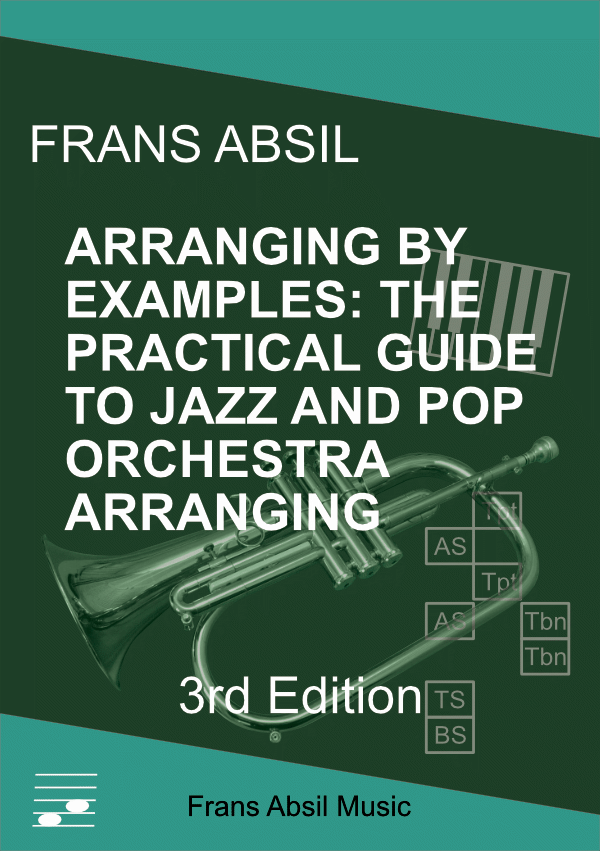 there are two new episodes on Sectional Harmony in Four Parts:
[6] The Subdominant Chord (3:53), and
[7] Diatonic Parallel Chords (4:14).
Listen to audio demos of individual parts and the full section.
there are two new episodes on Sectional Harmony in Four Parts:
[6] The Subdominant Chord (3:53), and
[7] Diatonic Parallel Chords (4:14).
Listen to audio demos of individual parts and the full section.
- Considerable time was spent on software debugging. As you may know I am a frequent user of the Liine Lemur app on the iPad, a most useful Midi/OSC controller design tool. I created many controller interfaces for software instruments and sample libraries. It has some quirks though, and last month I tried the Arturia KeyLab 61 Mk2 and the V Collection 6 set of virtual instruments. The keyboard has physical controls (knobs, faders, push buttons, keypads). The Midi Control Center application allows controller configuration design with user Midi CC mappings, and uploading to the 10 user memory slots on the keyboard. However, I failed at designing multiple templates in parallel. This turned out to be a software error in the unique naming of the controller elements. Took me while, performing test scenarios and pinpointing the error, including creating a movie that demonstrates the problem. Glad I could help the Arturia company improving their products. The virtual instruments collection is impressive, and I took my first steps at learning sound design in the Modular V3. Why? Well, because it brings back memories of my keyboard idol Keith Emerson, freaking out at the impressive control panels of his miracle Moog synthesizer. Only recently I learned that the oscilloscope on the top right of his rig was a fake. But why blame a good show-off?
- While editing some HTML pages I corrupted the Pitch-Class Set analysis GUI tool. The Analyse Set button was inactive for about a week, a problem kindly reported by an attentive user. I apologise to all users that may have been affected by this inconvenience.
<< Previous - Top of page - Next >>
April 2019: YouTube Music Composition and Arranging Techniques movies
There's new content on my YouTube video channel:
- In February 2019 I created the Arranging Techniques playlist, presenting audio companion material for the book "Arranging by Examples: The Practical Guide to Jazz and Pop Orchestra Arranging, 3rd Edition." Last month I added two more episodes on Sectional Harmony in Four Parts: [4] The Exact Parallel Chord (4:58), [5] The Minor 7th Chord (5:07).
- Watch
 Harmony Tension Level Control: Schillinger, Hindemith and Pitch-Class Sets, Part 5
(25:33).
This is the final episode in the series. After classifying PC-Sets with the Hindemith six chord groups scheme, these can be used in Schillinger Diatonic-Symmetric Harmony. Write modern harmony chord progressions with tension and dissonance level control. Part 5 discusses leading tone identification in chords with tritone intervals, the interval quality of the root movement in chord connections, balancing the outer parts, and extended tonality in cadences and longer progressions. The principles are demonstrated in chord progression and composition examples. You will find this movie in the Music Composition Techniques playlist.
Harmony Tension Level Control: Schillinger, Hindemith and Pitch-Class Sets, Part 5
(25:33).
This is the final episode in the series. After classifying PC-Sets with the Hindemith six chord groups scheme, these can be used in Schillinger Diatonic-Symmetric Harmony. Write modern harmony chord progressions with tension and dissonance level control. Part 5 discusses leading tone identification in chords with tritone intervals, the interval quality of the root movement in chord connections, balancing the outer parts, and extended tonality in cadences and longer progressions. The principles are demonstrated in chord progression and composition examples. You will find this movie in the Music Composition Techniques playlist.
- There's a short composition
 Aiba Kiln: Folk Tune from Brexitania for Small Orchestra (3:19). This orchestral piece with folk music character has a main melody with statements for solo trumpet, flute and solo violin. There are backgrounds for sustained strings and set as brass chorale, and a bridge section for electric guitar, electric piano and synthesizers with melodic fragments in imitation. The movie shows an annotated score.
Aiba Kiln: Folk Tune from Brexitania for Small Orchestra (3:19). This orchestral piece with folk music character has a main melody with statements for solo trumpet, flute and solo violin. There are backgrounds for sustained strings and set as brass chorale, and a bridge section for electric guitar, electric piano and synthesizers with melodic fragments in imitation. The movie shows an annotated score. - Read more about these and other YouTube videos. Descriptions and links.
<< Previous - Top of page - Next >>
March 2019: YouTube Arranging Techniques playlist started
New content on my YouTube video channel:
- The book "Arranging by Examples: The Practical Guide to Jazz and Pop Orchestra Arranging, 3rd Edition" encourages readers to play or enter the score examples with a keyboard. However, there have been requests for audio examples. Therefore I created the playlist Arranging Techniques, which now contains the first episodes on Sectional Harmony in Four Parts: [1] The Secondary Dominant Chord (4:54), [2] The Leading Tone Chord (3:24). [3] The Substitute Chord (6:10).
- Harmony Tension Level Control: Schillinger, Hindemith and Pitch-Class Sets, Part 4 (15:57). Another look at PC-Sets, to be used in the Schillinger Diatonic-Symmetric harmony system after mapping on the Hindemith chord classification scheme. For various 6-element sets there are example voicings. Two examples, one for orchestra, the other for wind quintet, will be derived from chord progressions with these sets. You will find this movie in the Music Composition Techniques playlist.
<< Previous - Top of page - Next >>
February 2019: Schillinger, Hindemith and Pitch-Class Sets, Part 3
Watch the YouTube video tutorial:
-
Harmony Tension Level Control: Schillinger, Hindemith and Pitch-Class Sets, Part 3 (22:30).
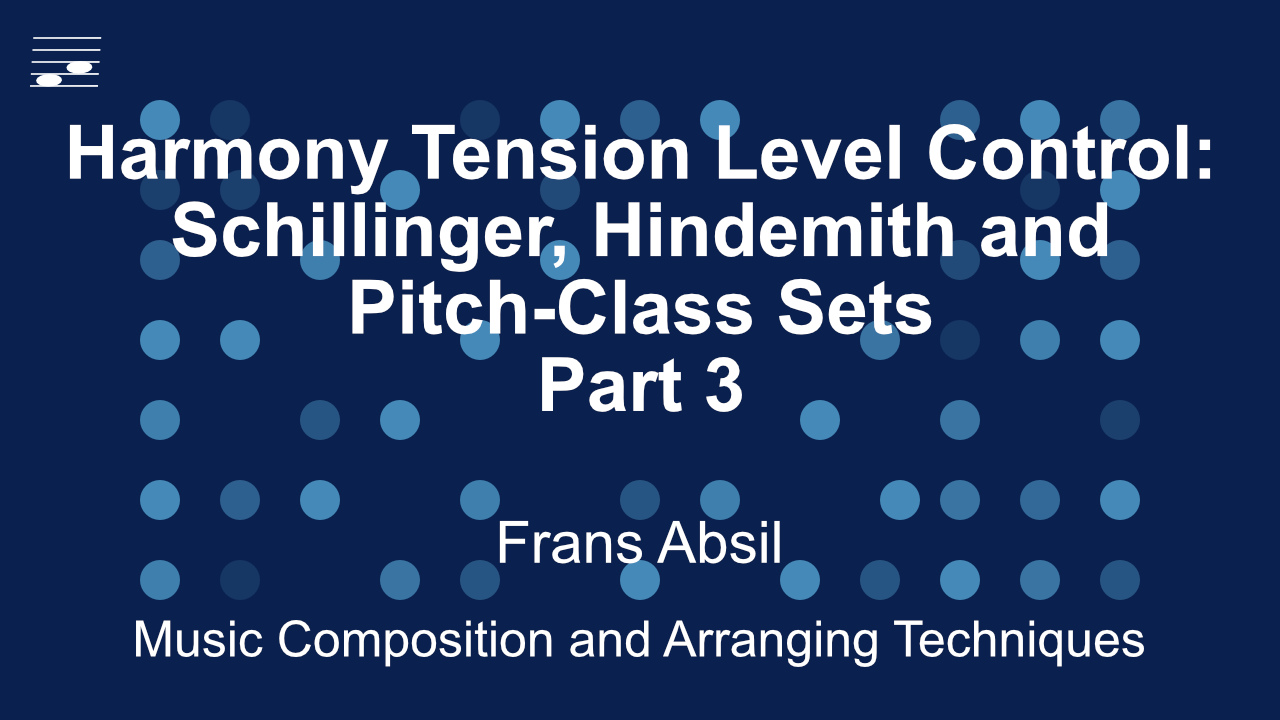 Use Pitch-Class Sets in Schillinger Diatonic-Symmetric Harmony after Hindemith Chord Group Classification. Control the harmony tension level in an extended tonality chord progression. The importance of the chord root and vertical dissonance distribution in the voicing. Fundamentals and examples. Part 3, 5-Element Sets. You will find this movie in the Music Composition Techniques playlist.
Use Pitch-Class Sets in Schillinger Diatonic-Symmetric Harmony after Hindemith Chord Group Classification. Control the harmony tension level in an extended tonality chord progression. The importance of the chord root and vertical dissonance distribution in the voicing. Fundamentals and examples. Part 3, 5-Element Sets. You will find this movie in the Music Composition Techniques playlist.
<< Previous - Top of page - Next >>
January 2019: New document, YouTube channel subscribers and videos
New content:
- YouTube Channel 500 Subscribers (2:20). Milestone reached on December 24, 2018. Thanks for the views and subscriptions. Plans for next year, help this channel to grow. Happy New Year!
- Harmony Tension Level Control: Schillinger, Hindemith and Pitch-Class Sets, Part 2 Tetrachords (24:10). Merge Schillinger Diatonic-Symmetric Harmony with the classification of all possible Pitch-Class Sets using Hindemith’s Chord Groups. Harmony tension control within a chord progression with an expanded pool of structures, including 28 4-element PC Sets. Fundamentals, three progressions and three orchestral examples. You will find this movie in the Music Composition Techniques playlist.
- Guitar Harmonics: An Overview in Diagram. The natural harmonics of the 6-string guitar. The mechanism for generating natural harmonics on a fretted string. Guitar natural harmonics in standard tuning, and in ascending pitch order. Mechanism for generating artificial harmonics. Minimum fair price: € 3. (4 pp., 198 kb, December 2018). This is a new addition to the Document Library.
- ADAM Audio Soundtrack Competition 2018 (0:30). My competition entry. Soundtrack to the photo by Tobias Zielony, The Opening (2005). Orchestral-electronic texture. Two phrases of atonal music, based on sets of 12-tone triads.
